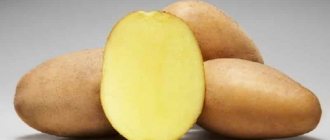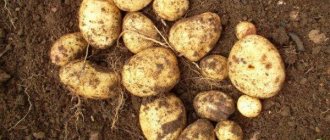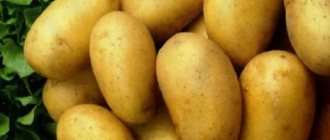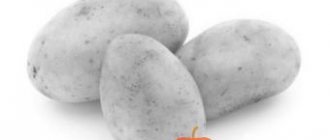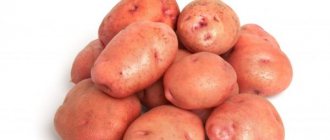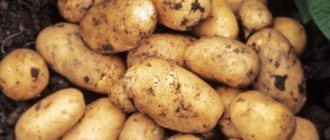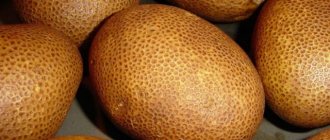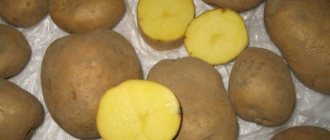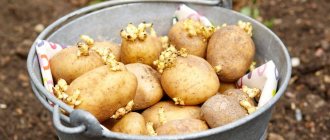Vegetable growing » Potatoes
0
2532
Article rating
Kira Stoletova
Kemerovo potatoes are a popular variety among farmers and ordinary people. It was specially created to be grown in any climate zone. This variety shows high productivity under any climatic conditions. Most of the fertile soil around the world was devoted to this type of potato.
Description of potatoes Kemerovo
Features of care
Caring for the Hostess is not particularly difficult and includes such activities as weeding, hilling, watering, fertilizing, and, if necessary, treatment against diseases and pests.
Weed control
If the Hostess was planted using the traditional method, without the use of black agricultural fiber covering the bed, in order to obtain a good harvest throughout the entire growing season, the gardener must regularly remove all weeds growing on the site, as well as loosen the soil after each watering. This problem can be solved by mulching, for which you can use straw, sawdust, peat or other organic materials.
Another specific technique for growing potatoes is hilling. Raking a large amount of soil under the bush in the form of a high, up to 5 cm, hill allows for more intensive growth of the root system, and this, in turn, leads to the formation of a larger number of tubers and prevents their shrinkage.
Watering and fertilizers
The hostess is highly drought-resistant, and therefore does not need regular watering. It is necessary to moisten the soil only when, at intensely high air temperatures, the amount of precipitation is minimal. You can tell that potatoes need watering by a change in leaf turgor (due to lack of moisture, they become soft and drooping).
Did you know? The famous agronomist of the 18th century, Antoine-Auguste Parmentier, instilled a love for potatoes among the distrustful French. All he had to do was post a heavily armed guard around a garden bed with an unknown crop, and “carelessly” remove it at night - and the locals immediately took the opportunity to steal and try the strange vegetable that they had guarded so carefully.
When watering, it is necessary to use water well heated in the sun and calculate its volume so that not only the surface of the soil is moistened, but also its deeper layers (the water should reach a depth of about 50 cm, this will completely provide the root system of the bush with moisture).
During the growing season, it is enough to feed the Hostess twice, both times before flowering begins (this guarantees the absence of nitrates hazardous to health in the root crops).
The first fertilizing can be done with organic matter, for example, chicken manure, compost or mullein mixed with garden soil. You can add a little wood ash to the same mixture, this will feed the bush with potassium. The second feeding may consist of a complex of mineral fertilizers.
So, for 1 sq. m of beds can be used:
- nitrophoska - 1 tbsp. l.;
- superphosphate - 2 tbsp. l.
The preparations are mixed with water (about 5 liters) and applied under the bush using regular watering.
Important! Before applying fertilizers, regardless of their composition, the bed must be watered abundantly, otherwise the nutrients will be poorly absorbed, and if applied in liquid form, they can even burn the root system.
Disease and pest control
Diseases for which Hostess shows minimal resistance begin to manifest themselves at very high temperatures, which is why the variety is aimed at growing in regions with cold summers.
If this rule is not followed, for preventive purposes it is recommended to treat the bed with fungicidal preparations containing copper (copper sulfate, copper sulfate, Bordeaux mixture) or manganese sulfate.
As for pests, the Hostess, like other potato varieties, can be attacked by the Colorado potato beetle, wireworm, mole cricket, cutworm caterpillars, potato moth, potato flea beetle, leafhoppers and other parasites.
Insecticidal preparations are used to combat them, but when choosing a particular product, it is important to take into account the characteristics of the pest, in particular, where it lives - in the soil or on the surface of the earth. So, against the Colorado potato beetle and other “aboveground” parasites you can use:
So, against the Colorado potato beetle and other “aboveground” parasites you can use:
- "Anti-Colorado";
- "Calypso";
- "Confidor";
- "Bombardier";
- "Hunter";
- "Connect";
- “Stop the bug”, etc.
It is better to combat mole crickets, wireworms and other soil pests with the help of:
- "Thunderbolt";
- "Medvetoxa U";
- "Bazudina";
- "Antikrobak"
- "Antimedvedki";
- "Scorpio";
- "Antikhrushcha" and others.
Growing order
To get a high-quality and large harvest, it is necessary to properly prepare planting material.
Note! Many gardeners choose large tubers for planting, weighing from 100 grams. This allows you to get a large harvest, but at the same time the consumption of tubers significantly increases, which requires additional costs for the purchase of seed material or for its storage. Therefore, it is much more effective to plant tubers weighing from 50 to 100 grams
If you cut large club plants when planting, you must ensure that each part placed in the hole has at least three eyes.
Therefore, it is much more effective to plant tubers weighing from 50 to 100 grams. If you cut large club plants when planting, you must ensure that each part placed in the hole has at least three eyes.
It is also recommended to germinate this potato variety. To do this, it is taken out of storage within 35-40 days and placed in a warm room with a constant temperature of 12 to 17 degrees Celsius.
Important! When preparing planting material using germination, attention should be paid to the lighting in the room. If there is insufficient light, the sprouts may be long and white, which will not produce a significant harvest. Excess light can cause the sprouts to dry out, which will also negatively affect the harvest.
Excess light can cause the sprouts to dry out, which will also negatively affect the harvest.
Excessive light can cause the sprouts to dry out, which will also negatively affect the harvest.
Don't forget about moderate watering
During the germination process, it is recommended to turn the seeds periodically (at least once a week), so they are placed in bulk on racks at this time. In addition, this method of storage during the period of preparation for planting allows the seeds to be treated with growth stimulants and mineral fertilizers. Resistance to pests and diseases will be added by treating varietal potatoes with a weak solution of copper sulfate during germination.
Additional Information. Some gardeners use a wet germination method. To do this, the tubers are placed in special boxes and sprinkled with wet sawdust or peat. This method of preparing potatoes for planting allows you to reduce germination time, and the tubers themselves retain most of the nutrients inside, which ensures a higher yield.
To plant Gornyak potatoes, you should choose a well-lit area with sunshine. Like other varieties of this crop, Gornyak does not like excess moisture, so if groundwater is close, it is better to plant the plant on higher ground. Site preparation begins in the fall. It is dug up and all weeds are removed. If the soil on the site is characterized by high acidity, then lime or dolomite flour should be added to it. In the spring, it is necessary to dig up the area again and apply fertilizer: humus or peat (if necessary).
The optimal time to plant Gornyak varietal potatoes is considered to be the end of April - the beginning of May, since they belong to the category of mid-season varieties. To be sure that the time for planting has arrived, it is recommended to measure the soil temperature at the depth of the shovel bayonet (12-15 centimeters). As soon as it reaches 7-8 degrees Celsius, it means that the seeds can be planted in the ground.
Productivity guaranteed
Caring for potatoes is quite simple. Firstly, it is necessary to periodically loosen the soil with a rake and remove weeds. This makes it easier for the first shoots to appear. As soon as the crop sprouts reach a height of 15-20 centimeters, they should be earthed up to ensure the development of the root system and the formation of a large harvest. Usually the natural level of precipitation is sufficient for potatoes, but in case of drought it is recommended to provide the plant with additional moisture in a volume of no more than 3 liters per bush. Feeding is carried out three times:
- The first is during the period of tops growth;
- The second - as the buds form;
- The third is during the period of flowering and ovary formation.
Planting and growing potatoes
Romano potatoes are not picky about growing conditions, but some minimum recommendations for choosing a location for plants must be followed.
Did you know? Potatoes were introduced into Europe around 1580, but were long considered unsuitable for food.
This will help get the maximum yield from the bushes and prevent problems from occurring.
- be well lit - in the shade the plants will grow much worse and the tubers in the nest will be small;
- have loose and nutritious soil - in heavy soil, planting material germinates worse, and a lack of fertilizer affects the quality and volume of the harvest;
- do not contain groundwater lying close to the surface of the earth - bushes react poorly to waterlogged soil. If potatoes are planted in an area with high groundwater levels, then planting should be done on ridges;
- to reduce the risk of diseases, it is not recommended to plant Romano potatoes in areas where tomatoes, peppers or eggplants were previously grown;
- A good harvest of tubers can be obtained if you plant the Romano variety in an area where grains or legumes, cabbage, greens, beets or carrots previously grew.
Mid-early potato varieties also include such as “Nevsky”, “Sante”, “Manifesto”, “Tuleevsky”, “Breeze”, “Zekura”.
Selection of planting material
In order for Romano potatoes to produce a good harvest, you need to start growing them with proper planting of the fruits. Proper preparation of seed tubers helps to obtain the first green shoots within 8–12 days after planting.
Let's consider the basic rules for selecting and preparing potatoes for planting:
- tubers must be free from deformation, damage and rot;
- the weight of one fruit should be about 80 g;
- 20 days before the planned planting, seed tubers are laid out in a warm (+14...+16°C) and well-lit place for germination;
- To prevent seed potatoes from drying out in a warm room, they are periodically sprayed with warm water;
- for better germination, seed tubers are treated with a solution of mineral fertilizers or a growth stimulator;
- to increase the plant’s immunity to diseases and pests, tubers are treated with fungicides before planting;
- if the potatoes are too large, then before planting the fruits are cut into pieces so that each of them has 2-3 eyes.
Important! Tubers are planted after sprouts up to 5 cm long appear on them.
Soil preparation
The highest yields are achieved when this variety is grown in fertile and loose soil.
Other types of soil require little preparation before planting potatoes:
- add lime or ash to acidic soil;
- dense clay soil is diluted with humus or peat (1 bucket is enough for 1 m²);
- sandy soil is fertilized with humus and diluted with clay soil;
- compost or manure, clay and coarse sand are added to peat soil.
In the fall, it is recommended to carry out deep digging of the site. This will help prevent the occurrence of diseases and improve the breathability of the soil. Before planting in the spring, the soil is dug up again to a depth of 20 cm and loosened with a harrow.
Planting potatoes
The timing of planting Romano potatoes in open ground largely depends on the climatic conditions of a particular region. For the southern regions, planting is possible as early as mid-April, provided that night frosts are not expected. In other regions, potatoes are planted in late May or early June.
Did you know? When exposed to direct sunlight, solanine, a substance poisonous to the human body, accumulates in potato tubers.
The process of planting Romano potatoes is described below:
- Dig holes in the soil 10–20 cm deep, placing them in rows at a distance of 60–80 cm from each other. The lighter the soil on the site, the greater the depth of the hole. Between the rows you need to leave a distance of about 50 cm.
- If the soil on the site is too dry, then the holes can be watered a little.
- Add humus, a handful of ash or mineral fertilizers to each hole.
- Place seed potatoes in the hole, sprouts facing up. If small fruits weighing about 20 g are used for planting, then 2-3 tubers should be placed in one hole.
- Sprinkle the hole with soil and slightly level the surface.
If Romano potatoes are planted in sandy soil, and the growing region is characterized by a hot, dry climate, then it is recommended to place the tubers in trenches up to 10 cm deep.
Features of cultivation
Although the Kemerovo potato is very unpretentious and highly productive, nevertheless, its yield and quality are largely determined by how well it was cared for.
Harvesting
Arizona Potatoes
One of the first steps in growing is the correct selection of seed material. It is recommended to choose small root vegetables for this purpose. In this case, it is advisable to use those that have many eyes.
Kemerovo potatoes grow well in sandy soils. It gives a good harvest if perennial plants and legumes were grown in this area before.
Before planting, selected root crops must undergo special pre-treatment. Its goal is to stimulate growth processes and strengthen those properties of potatoes that help it fight pests and diseases.
Then the processed seed varietal material in special containers is placed in a cool place, where it is kept for some time. It is recommended that the potato tubers be exposed to direct sunlight, which can increase the rate of sprout formation.
Now you need to plant the prepared tubers in the soil. This is done in the spring. Before this, you need to make sure that the soil has already warmed up sufficiently from frost, and its temperature is at least ten degrees. Kemerovo potatoes significantly depend on the temperature regime of the soil.
On a note! When planting root crops, you need to place them at the correct distance from each other. Planting takes place in beds, the distance between which should be from 40 to 45 cm. Along the bed, the distance between bushes is usually at least 60 cm. This is done so that the bushes do not interfere with each other during their development.
When planting Kemerovo, potatoes are not cut into pieces; only whole potatoes can be used. If this rule is violated, it can lead to a decrease in yield by up to 40%.
When three weeks have passed, it will be necessary to hill up the beds. In most cases, it is not necessary to do it again. This is only permissible in cases where the earth has crumbled and it is necessary to fill it up in a certain place.
Hilling up beds
Every two weeks you need to loosen the soil and remove weeds.
Watering is carried out for the first time two weeks after the mass emergence of seedlings. Then this must be done during the period when the plants are budding. During this watering, at least seven liters of water should be spent on each plant.
Important! It is believed that if during plant growth the soil is dry at least seven centimeters deep, you need to water the potato planting again.
Cleaning should be done as quickly as possible after the tops dry out.
Characteristics of the potato variety Explosive
Potatoes have a distinctive feature: they are able to maintain their varietal characteristics for 5 years or more, which allows gardeners to save on the purchase of seed material.
Productivity
The shape of the tubers of the crop is oval or round. According to the description and reviews of Explosive potatoes, the root vegetables are distinguished by a reddish-pink skin. The eyes are small and medium in depth.
The pulp of the tubers is creamy or yellowish. 8-14 potatoes are formed in one nest. They are similar in size, the weight of each varies from 110 to 150 g. The yield, subject to the rules of agricultural technology, reaches 450-500 c/ha.
Important! Tubers are formed 42-50 days after the start of plant development, but full maturation is noted after 60-70 days.
The taste qualities of Explosive potatoes are high; the tubers contain starch, the range of which varies from 16 to 22%. Its level depends on the following factors:
- a higher starch concentration is observed in potatoes that were not watered enough;
- the smallest amount of the substance is present in crops that were abundantly fertilized during the growing period.
Freshly picked tubers are mealy, boil well, without excess water. The dense skin of potatoes allows the variety to be used for cultivation for industrial purposes, harvesting by mechanization. The tubers are well stored: keeping quality is 95%.
Explosive potatoes are cultivated for personal consumption: root vegetables are used to prepare various dishes by boiling, stewing or frying.
Advantages and disadvantages
According to reviews, potatoes of the Vzryvny variety have the following number of advantages:
- high productivity;
- resilience to climate change;
- early ripeness;
- decent taste;
- strong immune system;
- simple agricultural technology.
The disadvantages of the variety include its instability to viral diseases, which requires additional preventive measures.
Landing Features
Drova potatoes are unpretentious in care, so even inexperienced gardeners can grow the variety
It is important to consider that due to the susceptibility of potatoes to fungal diseases, it is impossible to plant root crops in one place for several years in a row.
Planting material is prepared a month before planting. Only whole root vegetables should be used. The tubers are placed on newspaper in a sufficiently lit room, the temperature of which reaches 15 degrees Celsius. It is recommended to plant Firewood potatoes after the sprouts on the tubers have reached 2 cm.
Landing dates
Favorable time for planting potatoes Firewood is the beginning - mid-May. It is recommended to plant the root crop when the soil has warmed up to 10 degrees Celsius.
Site preparation
To grow Drova potatoes, you must select a site near which plants belonging to the Solanaceae family will not be grown. This is due to the fact that both cultures have similar diseases and if one culture gets sick, the second will get sick too.
In addition, the Firewood variety is not recommended to be planted next to trees, since the roots will destroy the potato tubers.
Planting scheme
To plant Firewood potatoes, you need to dig holes 10 cm deep and fill them with wood ash. It is necessary to leave a distance of 30 cm between seedlings, and 60 cm between beds.
How to grow?
For the best harvest, it is necessary to plant the plants in an open field and regularly water and weed, removing weeds that may interfere with the uniform growth of plants and their fruits. At the same time, potatoes grow well in dry areas, and also, conversely, in excessively wet areas. In the latter case, this variety can even boast resistance to putrefactive bacteria, and it is immune to many viral diseases, especially to the golden potato nematode. But against Colorado potato beetles and other insect pests you will have to use special products. Such disease resistance is an excellent characteristic of a variety, since a decrease in yield often directly depends on similar diseases that are transmitted from tuber to tuber.
The best option for growing are soils with a high content of sandy deposits, which is necessary for the removal of excess moisture and a high oxygen content in the soil. Before planting, you should carefully select fruit material
It is worth paying attention to small potatoes with a large number of eyes - the fruit will send shoots through them. Selected fruits should be placed in a box or special container, place it in a cool room with sufficient sunlight
After some time, the potatoes will sprout and be ready for planting.
You should not cut the fruits to increase the number of final bushes - this will negatively affect the yield, because the fruit without the peel is much more susceptible to various diseases, pests and mechanical damage.
It is necessary to plant potatoes at the end of spring, when the soil has already warmed up sufficiently under the sun's rays and its temperature does not drop below +10°C. As with other potato varieties, it is necessary to maintain a distance between the bushes - it should be at least 40 cm, otherwise the tubers may not develop to the required size.
Do not forget also about the need to loosen the soil every two weeks and regularly water the plantings if the area is not rainy enough. An installation with drip irrigation is well suited for this, as it allows you to provide moderate moisture to the soil and avoid flooding the plants to a fatal state. The crop is harvested when the tops begin to noticeably dry out - this is a sure sign that the plant has completed its life cycle and the fruit tuber is ready for “dormant mode.”
Important! The Kemerovo potato has taken root well in regions such as Krasnoyarsk, Khakassia, Tyva, Novosibirsk region, Kemerovo and many others. It is grown by amateur gardeners, farms, and even large collective farm enterprises.
Among gardeners, this variety is positively rated for its resistance to weather conditions and high yield. It can be easily grown in almost any climate of Russian latitudes; it can be easily harvested using special harvesting equipment.
In addition, “Kemerovochanin” can be stored for several months in a cool room without compromising quality or transported over any distance without requiring specific transportation conditions. Potatoes are distinguished by their high quality presentation and good taste parameters.
However, this variety is not universal enough to use. It is not recommended to make fried potatoes or mashed potatoes from it, as the fruits are too harsh for this. “Kemerovochanin” is much better suited for preparing soups and salads, especially fish ones, as well as for the traditional “Olivier” salad.
In the next video you will find characteristics of popular potato varieties, including the Kemerovo variety.
Characteristics of Kemerovo potatoes
The variety was bred by breeders from the Vsevolozhsk station in the Russian Federation in 1976. However, Kemerovo resident was included in the state register only in 1982. It is popular among Ukrainian and Moldavian vegetable growers.
In terms of ripening time, potatoes are classified as mid-early varieties, since the vegetable is dug up 65-80 days after planting.
The Kemerovo potato, like the Drova variety, is distinguished by its high yield: from one bush you can dig up about 30 tubers weighing up to 200 grams.
- Characteristics of the plant bushes: the bushes are lush, short in stature (80-100 cm) and located around their axis;
- Characteristics of the leaves: the foliage is moderate with slight ribbing and has a light green color;
- Characteristics of the inflorescence: they consist of several flowers and have a light white color;
- The fruits are oval-shaped with small pink or purple eyes;
- Characteristics of the peel: the peel is light yellow in color, which appears in a netted form;
- The pulp of the fruit is quite soft and has a bright cream color;
- The starch content reaches 15%-17%.
As a rule, Kemerovo potatoes are not used for making mashed potatoes or French fries. This variety is ideal for making soup or salad.
Diseases and pests
An important advantage of Meteor is its immunity. Thus, this variety is well resistant to cancer, dry and ring rot, rhizoctonia, and golden potato nematode.
It has average resistance to the causative agent of late blight, scab, Alternaria and moderate resistance to wrinkled and striped mosaics. It resists the Colorado potato beetle and aphids well.
As you can see, Meteor potatoes have excellent protection against many diseases and pests, so, basically, they do not require any additional safety measures.
The only thing that can be done is preventive spraying with insecticides. This procedure will protect your bushes from most harmful insects.
However, you may find useful information on combating the Colorado potato beetle available on our website useful.
We bring to your attention articles about folk methods and chemicals.
As for winter storage, nothing special is required. The main thing is to follow the basic rules, know the deadlines, and choose a good place.
Potato "Meteor" is a very young, but at the same time very promising potato variety. The advantages of this potato are obvious: excellent table quality, the possibility of vacuum packaging, good keeping quality and yield. And the possibility of cultivation in many regions of the country leaves no doubt that it will become popular in the near future.
We also bring to your attention other potato varieties with different ripening periods:
| Late ripening | Mid-early | Mid-late |
| Picasso | Black Prince | Blue |
| Ivan da Marya | Nevsky | Lorch |
| Rocco | Dark-skinned girl | Rowanushka |
| Slav | Lord of the Expanses | Nevsky |
| Kiwi | Ramos | Courage |
| Cardinal | Taisiya | Beauty |
| Asterix | Lapot | Milady |
Care
According to its characteristics, Kemerovo does not require special care: the bushes need to be watered, saturate the soil with minerals, hill up and carry out preventive spraying against parasites and weeds.
Loosening
Loosening of the land plot with the Kemerovochanin variety is carried out once every 2 weeks. This process helps provide the plant’s root system with oxygen. In addition, loosening ensures weed removal.
Along with loosening, the Kemerovo variety is also watered. He recommends watering using the drip method so that water gets not only into the roots, but also onto the plant itself.
Mulching
Mulching of the soil is carried out, as a rule, in the autumn season, when the beds are cleared of the predecessors of the Kemerovo potato variety. When mulching, the land plot is carefully dug up and saturated with mineral fertilizers. As a rule, the soil is fed with organic matter.
Hilling
Hilling up of Kemerovo potato beds is carried out 3 weeks after planting. The procedure is repeated if there is subsidence of the soil, which does not properly cover most of the bushes.
Zhukovsky early
This early ripening table variety can be started to dig up on the 50th day from the emergence of shoots. It has quite large, highly branched bushes. The smooth surface of early Zhukovsky potatoes can be colored pink or red. The weight characteristics of the variety will be between 122 and 167 grams.
Important! Zhukovsky early has a fairly dense skin, which perfectly protects the pulp from damage. Many gardeners fell in love with Zhukovsky early potatoes thanks to its white flesh, which does not darken after cutting.
The starch content in it will be from 10 to 15%. The excellent taste and commercial qualities of potatoes of this variety are complemented by good resistance to potato cancer and nematodes.
Many gardeners fell in love with early Zhukovsky potatoes due to their white flesh, which does not darken after cutting. The starch content in it will be from 10 to 15%. The excellent taste and commercial qualities of potatoes of this variety are complemented by good resistance to potato cancer and nematodes.
Seed potato varieties - choose the right ones
It is worth saying that potatoes have weaker protection against all kinds of pests and infections than other vegetables.
If this is not taken into account, the tubers will work solely to survive rather than focus on a good harvest
The only exceptions can be those varieties that successfully resist many of their varieties. But not all resistant varieties have better taste and large fruit. That is why the choice of varieties must be taken with full responsibility.
It should also be taken into account that after 3-4 years the variety will degenerate, which means that it is necessary to find an appropriate replacement for it. An ideal option would be elite planting material. It will be extremely difficult to grow it yourself, because it is a very long and intensive process that requires specific conditions.
When purchasing it, it would not be superfluous to ask the seller about the quality certificate. This is relevant due to the fact that very often sellers can offer ordinary potatoes instead of the desired elite planting material.
If you do not want the purchased planting material to become unusable too quickly, then it should be dug up before the lion's share of the harvest begins to appear.
As for the characteristics of the varieties, here it is also worth being vigilant not only about traditional factors (taste, yield and large-fruited), but also several others (early maturity and the place where it comes from)
Compliance with the last factor will help determine the compatibility of the climate zone, which is extremely important when growing potatoes
Advantages and disadvantages of the Timo variety
The benefits of potatoes consist of the following points:
- can be stored for a long time, both in warehouses and in home basements;
- high degree of productivity on any soil;
- stress-resistant to weather changes;
- the ripening period is short;
- resistant to several types of diseases.
There are also disadvantages:
- due to the short ripening period, the tubers begin to germinate early, so it is necessary to cut off the shoots several times during the storage period;
- like most varieties, it has low resistance to late blight and nematode;
- does not like sudden cold snaps.
Features of growing and caring for the “Timo Hankkiyan” variety
- First you need to prepare the area where you will plant the tubers. In autumn, the soil is dug up and manure is spread. Mineral fertilizers are applied when planting tubers in the ground.
- The holes are made with a shovel approximately 30-40 cm apart. Large and heavily germinated tubers are placed one per hole, small potatoes are placed in two or three pieces. After all, there is a possibility that one of them will not have the strength to form a sufficient number of potatoes under the bush. More progressive farmers have long forgotten about the shovel and use walk-behind tractors to dig trenches. Tubers are placed in these grooves at a distance of 30-40 cm, as when planting in holes.
- The best method of watering is drip irrigation. You don't need to constantly monitor him. Plants are watered at the roots, water consumption is lower, and efficiency is higher.
- Loosen the soil periodically and let the roots breathe. Spray potatoes in a timely manner against the Colorado potato beetle, late blight and other diseases.
I have been growing potatoes all my life. I bought the Timo variety online. I planted it for brood. I constantly change different varieties, because I noticed statistics that the yield of potatoes on the same land is decreasing. New potatoes began to be harvested in June. I liked its taste. It cooks quite quickly and is soft. It fries perfectly, I especially liked its crispy crust. The first year the harvest pleased us, let's see how it will behave in the future. I can’t answer anything about storage; I also don’t know how it will be stored. Overall, I'm happy with my purchase.
We grow a few potatoes in a small summer cottage, but every year there is a new variety. Here, I found Timo potatoes in this one. We planted it at the end of April and started eating it in June. The taste is rich, sweetish. The mashed potatoes and roasts turn out magical. The family liked it, and this is the most important criterion.
Potatoes "Timo" will become one of your favorite varieties that you should try to grow in your garden.
Growing unpretentious and high-yielding varieties of agricultural crops is the best option for regions of Russia with unfavorable climatic conditions. Important factors are the presence of resistance to pests and good taste. Potatoes of the “Timo Hankkiyan” variety have earned the trust of vegetable growers.
Potato varieties:
Agricultural technology
The variety tolerates drought well and at the same time grows in moist soils. It prefers sandy loam soil, and on loam its taste characteristics and yield can be significantly reduced.
Note. Potatoes have good immunity to diseases such as potato canker, blackleg, and rhizoctonia.
Not very resistant to late blight. But this disease does not have time to greatly harm the potatoes, since their heyday occurs in the second half of summer, and during this period Timo is already removed from the fields.
The leaf curl virus is also not dangerous for this variety. Thanks to this stability, the variety does not degenerate even if you do not annually update the seed material. The worst enemies are the Colorado potato beetle and the golden nematode. Treatment against these insects is necessary.
The process of growing this variety is quite simple.
Particular attention should be paid to pre-planting seed treatment, then the yield will be much higher
Before planting, it is important to carry out the preparatory stage, which is carried out a month in advance. The tubers must be sorted and dried, getting rid of rotten and damaged specimens
Tubers no larger than a chicken egg are suitable as planting material. But periodic use of larger specimens can further preserve the variety from degeneration
The tubers must be sorted and dried, getting rid of rotten and damaged specimens. Tubers no larger than a chicken egg are suitable as planting material. But periodic use of larger specimens can further preserve the variety from degeneration.
Advice. Before planting, each tuber must be divided into 2 halves so that the number of eyes that have already sprouted is in approximately the same proportion in both halves. The prepared material should be transferred to a comfortable, warm room, first sprayed with water and covered with a cloth.
This period is also suitable for treatment with drugs that provide protection against various types of pathogens. It is useful to sprinkle with ash. The property of ash to activate starch synthesis can improve the taste of potatoes. Ash can be sprinkled not only on tubers, but also on holes, as well as soil in the spring and autumn.
Description of the Kiwi potato variety
The Kiwi potato variety is perhaps one of the rarest both on the market and on the user’s table. It has not received wide fame among entrepreneurs due to its long gestation period (about 120 days).
But everyone has their own taste and there are agronomists who consider this variety to be the best of its kind. After all, “Kiwi” has excellent taste, yield, and preservation.
In this article you will read a description of the variety, reviews about this root crop, and also see it in the photo. Let's start.
Chemistry or not
Due to its low popularity, almost nothing is known about this variety. Moreover, there is no direct standard, since Kiwi potatoes are not on the government register.
This variety resists the Colorado potato beetle well. Because of this, there is an opinion that in order to obtain such protection, the Colorado gene was introduced into the structure of the potato. In reality, everything is different.
The Colorado potato beetle does not prefer Kiwi just because it contains biofiber. It was formed as part of the artificial selection of different potato varieties.
Therefore, the myths about the presence of the Colorado gene in potatoes are completely absurd.
Description
Kiwi potatoes are one of the best varieties in terms of yield. It takes a long time to ripen, about 4 months in favorable climatic conditions. In cold regions, the ripening period increases to 130-135 days.
The tops are tall and straight. On average, it reaches a height of 50-60 cm. There are many leaves. They have jagged edges and a rough surface. The flowers of the tuber are bright lilac.
From two tubers, with proper care, you can get about a bucket of harvest. Kiwi potatoes have one distinctive property. When ripe, it is very difficult to find small root vegetables. There will be beautiful, large fruits in the hole. Thanks to this, the variety has no problems with yield.
Potatoes are great for making mashed potatoes and salads, as they boil well. But it is not recommended to fry it, as it often burns to the pan. As for the taste, it is pleasant, but not for everyone. If we compare it with the varieties “Udacha” and “Rozara”, then it clearly loses to them.
Advantages and disadvantages of the variety
Kiwi potatoes, despite their strange appearance, have gained enormous recognition among gardeners. This popularity is due to a number of advantages that an agronomist receives when cultivating this particular variety:
- This is a productive variety. With high-quality care and growing conditions, Kiwi can produce a 20-fold yield of the total mass of planting material.
- Tubers are resistant to diseases such as scab, late blight, and rot. Also, it is rarely affected by wireworms and the Colorado potato beetle.
- Has a good presentation. Many people buy Kiwi solely because of its unique appearance. The tubers look beautiful and are easy to clean thanks to the small number of eyes.
At the same time, it is worth noting a number of disadvantages. Among them:
- Tubers take a very long time to heat treatment. The tuber becomes suitable for consumption only 40 minutes after the start of cooking.
- Kiwi potatoes are very rarely used for frying as they often stick to the pan.
- The taste of Kiwi can be called specific. People often note that Kiwi has no distinct taste and is simply a tasteless potato.
general characteristics
The table potato variety “Nevsky” is classified as a mid-early variety. It is distinguished by both rapid growth of tops and early formation of medium-sized tubers. The potatoes are quite heavy. The variety is suitable for widespread cultivation. Has excellent taste. Vegetables are characterized by high resistance to many diseases and pests.
Appearance: description and photo
Escapes
The height of the bushes is 0.5–0.6 m. The stems of the variety are spreading or erect, heavily leafy, with a powerful root system. It blooms briefly, but intensely. Buds painted white with bright orange pistils. Potato inflorescences "Nevsky" are racemose. The small, light green foliage has a glossy surface with jagged edges.
Roots
Mature, weighty potatoes with yellowish skin have an oblong-oval shape. The juicy pulp is colored in a rich creamy shade. There are noticeable pink eyes on the tubers. The skin is smooth, but very thin.
Seeding rate and yield per 1 ha
Taking into account the technology of planting the variety, it is noted that with a width between rows of 60 cm, 16 stripes are placed without indentation on 1 acre. With a space between holes of 50 cm, typical for planting, the consumption of tubers in a row is 20 pcs. Medium-sized potatoes are best suited for planting, weighing approximately 95 g. To plant on one hundred square meters, you need to take 320 tubers, which is 30.4 kg. The consumption of seed material per 1 hectare will be 3.04 tons.
Important!
One of the main advantages of the Nevsky potato is its high yield. From 8 to 14 tubers are formed on one bush. From 35 to 50 tons of potatoes are harvested from 1 hectare of cultivated area. The average is 45 tons.
Taste characteristics
According to the characteristics of boilability, the variety belongs to table type A. The taste of potatoes is good, they are best manifested in various salads and soups. The juicy pulp holds its shape perfectly, does not crumble, and is slightly boiled.
Chemical composition
The degree of starchiness is 10–14.8%.
Nevsky potatoes are distinguished by a high content of vitamin C (from 32 to 41 mg per 100 g of product). Considered low in calories. 100 g of vegetables contains no more than 80 kcal. The tubers contain a high concentration of carotenoids.
Average tuber weight
Small potatoes are quite weighty. The average weight of tubers is 90 g. In favorable conditions, it is possible to grow vegetables weighing 130 g.
Marketability
The variety is resistant to mechanical damage, despite the thin peel. Tubers are well transported. The yield of marketable products from the total amount of harvested crop is impressive, it is equal to 92–95%.
Resistance to diseases and pests
The Nevsky variety is characterized by stable immunity to the following diseases and pests:
- potato cancer;
- wet rot;
- blackleg;
- viruses A, Y, X;
- potato flies;
- Colorado potato beetles (subject to closely spaced nightshade plantings).
An average degree of resistance is observed to rhizoctonia, common scab, and late blight.
Keeping quality
The variety is suitable for long-term storage. Tubers are little susceptible to rotting; given proper temperature conditions, vegetables are stored almost until spring. The degree of keeping quality is 89–96%.
Where is it used?
“Nevsky” is the best potato variety for making soups and salads. The pulp is slightly boiled. Due to the low starch concentration, the tubers are not fried or pureed.
Potatoes "Nevsky" are adapted to any environmental conditions. Grown everywhere. Approximately 26% of all areas allocated for planting potatoes in the Russian Federation are used for cultivating this particular variety. The largest harvests are harvested in regions with fertile sandy loam and light loamy arable soil.
Harvest and storage
Young potatoes for food and for sale begin to be dug 45 days after planting. You should start preparing for digging for long-term storage when the tops lose their turgor and begin to wither. At this stage, it is mowed with a scythe, leaving stumps 10 cm high. A week later, they select a hot, windy day and begin to remove the potatoes from the soil. After digging, the potatoes are laid out directly on the site next to the trenches and left there for 2-3 hours. This procedure allows you to warm the tubers under the sun and destroy most of the bacteria characteristic of the soil microflora.
After this, the tubers are sorted, separating:
- seed material;
- fruits for food in the near future;
- potatoes for long-term storage;
- damaged copies.
We advise you to find out when is the best time to harvest potatoes according to the lunar calendar.
Optimal storage conditions involve maintaining:
- temperature range within +3…+6°С;
- humidity at 75%.
In addition, it is important to provide the potatoes with complete darkness. Only under such conditions will the potato keeping quality of 96%, declared by the originators of the variety, be valid. If storage conditions are not met, it may decrease by 10–20%
The Red Sonya potato variety is a progressive German breeding achievement. It is undemanding in care and shows good yield results in any growing conditions
If storage conditions are not met, it may decrease by 10–20%. The Red Sonya potato variety is a progressive German breeding achievement. It is undemanding in care and shows good yield results in any growing conditions.
Growing rules
In order to grow this type of plant, you should choose sandy soils. This will increase the quality of the yield. First of all, you need to select seed material. It should be small in size and have a large number of eyes. Treat the material with special substances that will enhance growth and help fight pests. After this, the containers with the seeds are placed in a cool place where there is a lot of sunlight. This will speed up the process of sprout formation.
Planting is carried out at a time when the soil has already warmed up after frost, and its temperature is about 10°C. Due to the fact that this potato variety is quite dependent on temperature conditions, it should be promptly harvested. As soon as it is noticed that the tops have already dried, you can safely begin harvesting.
How to get a high yield
You can get a high potato yield in Siberia in different ways.
Growing in a greenhouse
For cultivation in a greenhouse, tubers begin to be prepared in November. When sprouts appear, the potatoes are transferred to boxes with wet sawdust or peat, and taken to a heated greenhouse. When the time for planting comes, the tubers will have formed strong shoots and roots. The holes are dug according to a pattern of 70*25 cm, 8 cm deep. A layer of peat or humus must be placed on the bottom, tubers on top and all this is sprinkled with a layer of earth. There is no need to water the plantings, otherwise you will create an excess of moisture and the tubers will rot. When the shoots appear and the soil dries out, then you can water the potatoes for the first time. During the period of growth, flowering and formation of tubers, the humidity in the greenhouse should be at least 80–100 percent. The air temperature must be maintained around +23 degrees. During the period of mass formation of tubers, it should be slightly lowered to +19 degrees. The harvest in the greenhouse reaches 350 kg per hundred square meters, and it is not exposed to diseases or pest attacks. Ideal for growing potatoes.
A greenhouse is an ideal place for growing potatoes
If your greenhouse is occupied by tomatoes, cucumbers or other crops, and there is absolutely no room in it for potatoes, creating a greenhouse will help you. Plant the potatoes in the beds, install the arcs, stretch the film, pressing it to the ground and the greenhouse is ready. The film retains heat well, but does not allow air to pass through. Therefore, in good weather it will need to be opened for ventilation, weeding, watering and fertilizing of plants. The greenhouse must be closed at night. Thanks to the created conditions, you will get the harvest ahead of schedule.
The greenhouse retains heat well
Raised beds
Since the soil in Siberia takes a very long time to warm up, you can use the method of growing potatoes in high beds. In the fall, they are formed about half a meter high with the help of hay, soil and manure. Potatoes can be planted in these beds two weeks earlier than in open ground. To speed up the heating of the soil, the following method is often used: pour plenty of hot water and cover with film. After the soil has warmed up, the tubers are placed in it. It is better to cover the plantings until the frost leaves.
Raised beds allow potatoes to be planted earlier
Chinese method
The essence of the Chinese method is as follows: in the fall you need to dig a trench 50 cm deep, make three holes in it 70 * 70 cm, about half a meter deep, at a distance of 25 cm from each other. Organic matter in the form of grass, leaves, food waste, hay is placed at the bottom of the pit, and ash is added (2-3 cups).
In the spring, when the soil warms up to +7 degrees, half a bucket of humus is poured into the bottom of each hole, three potatoes are laid and sprinkled with 10 cm of soil. The potatoes are prepared before planting: a transverse cut is made in the middle of the tuber, so that an intact jumper 1 cm wide remains in the center. The plantings look like a trench with mounds, which must be mulched with straw.
As the potatoes grow, you will need to periodically add soil and fertilize them with bird droppings diluted in water, in a ratio of 20:1, respectively. Water the trenches as the soil dries, during hot periods - at least once a week.
When the trench is completely filled with earth, you need to let the plant rise to a height of 30 cm, then bend it to the ground, dig it in and tear off the lower leaves. As they grow, the bushes continue to be sprinkled with soil and sprayed, and the flowers are removed.
When planting potatoes at the end of April, in July you can harvest the first harvest: up to 16 tubers weighing 1.7 kg from one mound. By autumn, the yield increases to 24 kg per planted tuber.
Attention, TODAY only!

